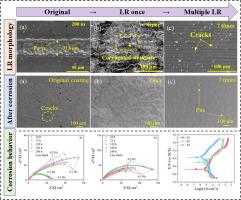Enhanced corrosion resistance of electrochemical deposited amorphous NiP coatings with surface cracks via nanosecond laser remelting: Effect of pulse width and cycle number on remelted layer
IF 6.1
2区 材料科学
Q1 MATERIALS SCIENCE, COATINGS & FILMS
引用次数: 0
Abstract
The amorphous Ni![]() P alloy coating is prone to forming surface cracks during electrochemical deposition, which weakens its corrosion resistance. In this study, nanosecond (ns) laser remelting (LR) was used to seal these cracks for surface modification. The study focused on the effects of ns-laser pulse width and the number of LR cycles on crack sealing efficiency and surface quality, with further evaluation of the electrochemical corrosion behavior. The results demonstrate that pulse width significantly affects both the effectiveness of crack sealing and the quality of the remelted surface (including pores and spatter). The optimal overall effect was achieved at a pulse width of 200 ns. The number of LR cycles significantly influenced the surface quality of the remelted layer. Compared to the original coating, a single LR cycle resulted in a considerable increase in surface roughness, accompanied by numerous pores. However, multiple LR cycles (7 cycles) effectively reduced surface roughness (approximately 75 %) and minimized surface defects, though with the formation of minor thermal microcracks. Additionally, the number of LR cycles showed negligible effects on both the remelted layer thickness and the degree of crystallization. Electrochemical corrosion tests revealed that LR significantly enhanced the coating's corrosion resistance. After 7 cycles of LR, the corrosion rate decreased by approximately 7.9 times compared to the original coating. This improvement is primarily attributed to the effective sealing of cracks in the remelted layer, which shifts the corrosion mechanism from corrosion-induced crack propagation to pitting corrosion. This study provides valuable guidance for implementing LR to modify electrodeposited coating surfaces.
P alloy coating is prone to forming surface cracks during electrochemical deposition, which weakens its corrosion resistance. In this study, nanosecond (ns) laser remelting (LR) was used to seal these cracks for surface modification. The study focused on the effects of ns-laser pulse width and the number of LR cycles on crack sealing efficiency and surface quality, with further evaluation of the electrochemical corrosion behavior. The results demonstrate that pulse width significantly affects both the effectiveness of crack sealing and the quality of the remelted surface (including pores and spatter). The optimal overall effect was achieved at a pulse width of 200 ns. The number of LR cycles significantly influenced the surface quality of the remelted layer. Compared to the original coating, a single LR cycle resulted in a considerable increase in surface roughness, accompanied by numerous pores. However, multiple LR cycles (7 cycles) effectively reduced surface roughness (approximately 75 %) and minimized surface defects, though with the formation of minor thermal microcracks. Additionally, the number of LR cycles showed negligible effects on both the remelted layer thickness and the degree of crystallization. Electrochemical corrosion tests revealed that LR significantly enhanced the coating's corrosion resistance. After 7 cycles of LR, the corrosion rate decreased by approximately 7.9 times compared to the original coating. This improvement is primarily attributed to the effective sealing of cracks in the remelted layer, which shifts the corrosion mechanism from corrosion-induced crack propagation to pitting corrosion. This study provides valuable guidance for implementing LR to modify electrodeposited coating surfaces.

纳秒激光重熔提高表面裂纹的电化学沉积非晶态NiP涂层的耐蚀性:脉冲宽度和周期数对重熔层的影响
非晶NiP合金涂层在电化学沉积过程中容易形成表面裂纹,使其耐蚀性降低。本研究采用纳秒(ns)激光重熔(LR)技术对裂纹进行表面改性。研究了ns激光脉冲宽度和LR循环次数对裂纹密封效率和表面质量的影响,并进一步评价了电化学腐蚀行为。结果表明,脉冲宽度对裂纹密封效果和重熔表面(包括气孔和飞溅)质量均有显著影响。在脉冲宽度为200ns时获得了最佳的总体效果。LR循环次数显著影响重熔层的表面质量。与原始涂层相比,单次LR循环导致表面粗糙度显着增加,并伴有许多孔隙。然而,多次LR循环(7次循环)有效地降低了表面粗糙度(约75%)并最小化了表面缺陷,尽管会形成较小的热微裂纹。此外,LR循环次数对重熔层厚度和结晶程度的影响可以忽略不计。电化学腐蚀试验表明,LR显著提高了涂层的耐蚀性。经过7次LR循环后,与原始涂层相比,腐蚀速率降低了约7.9倍。这种改善主要归功于有效地密封了重熔层中的裂纹,将腐蚀机制从腐蚀引起的裂纹扩展转变为点蚀。该研究为实现LR修饰电沉积涂层表面提供了有价值的指导。
本文章由计算机程序翻译,如有差异,请以英文原文为准。
求助全文
约1分钟内获得全文
求助全文
来源期刊

Surface & Coatings Technology
工程技术-材料科学:膜
CiteScore
10.00
自引率
11.10%
发文量
921
审稿时长
19 days
期刊介绍:
Surface and Coatings Technology is an international archival journal publishing scientific papers on significant developments in surface and interface engineering to modify and improve the surface properties of materials for protection in demanding contact conditions or aggressive environments, or for enhanced functional performance. Contributions range from original scientific articles concerned with fundamental and applied aspects of research or direct applications of metallic, inorganic, organic and composite coatings, to invited reviews of current technology in specific areas. Papers submitted to this journal are expected to be in line with the following aspects in processes, and properties/performance:
A. Processes: Physical and chemical vapour deposition techniques, thermal and plasma spraying, surface modification by directed energy techniques such as ion, electron and laser beams, thermo-chemical treatment, wet chemical and electrochemical processes such as plating, sol-gel coating, anodization, plasma electrolytic oxidation, etc., but excluding painting.
B. Properties/performance: friction performance, wear resistance (e.g., abrasion, erosion, fretting, etc), corrosion and oxidation resistance, thermal protection, diffusion resistance, hydrophilicity/hydrophobicity, and properties relevant to smart materials behaviour and enhanced multifunctional performance for environmental, energy and medical applications, but excluding device aspects.
 求助内容:
求助内容: 应助结果提醒方式:
应助结果提醒方式:


